Satyajit Ray
— by Jyotirmoy Datta
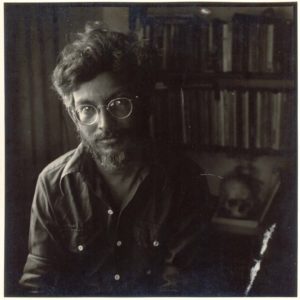
(Reading Time: 30 min Approx)
In 1989, during my first extended stay in New York, I was suddenly struck by a wave of Ray nostalgia. It was no coincidence perhaps that I had recently finished writing The Shadow Lines, which is, of all my novels, the one that more clearly shows the influence of Satyajit Ray. It struck me that Ray too had once been a stranger in this overwhelming city; that he too had walked the streets on Manhattan in Kolkata-bought shoes. One day, plucking up my courage, I made an appointment with the director James Ivory, who I knew to be a friend of Ray’s. Later that week I went to interview Ivory, cassette recorder in hand.
This is how Ivory described his first meeting with Ray, in the winter of 1960: ‘I looked him up in Calcutta,’ Ivory said. ‘I had never met him. I had seen at that point, Pather Panchali (‘Song of the Road’) and Aparajito (‘Undefeated,). I knew that Apur Sansar (‘The World of Apu’) existed and that sooner or later it would get to New York, but up till then it hadn’t come. And then some Indian friends of mine in Delhi said that apart from the trilogy he had also made some other films in that time – the late fifties.

They described Jalsaghar (The Music Room,) to me and that sounded like something I would love to see. Then I made kind of a long trip to Calcutta and went down to Puri, Bhubaneshwar and Madras. While I was in Calcutta, I just decided to call him. Just to meet him, but also to ask if it would be possible to see Jalsaghar. My friends in Delhi said he was very approachable (which he was) and I just called him up. He was in the phone book, so I just called him up and told him who I was. He said fine, he would try and arrange Jalsaghar for me. We agreed to meet in a coffee house, and I went there. He was alone and we talked.
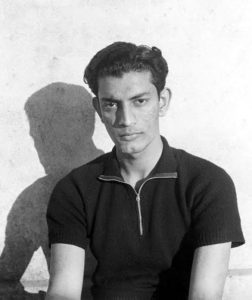
‘He was immensely tall; he was probably the tallest Indian I have ever met and that seemed symbolically apt. He had a kind of straightforward majesty about him; he was obviously a king, but he was an approachable king. We were friends all his life as long as he lived. Whenever there was something he needed, we tried to help. He always helped us. When there was some tremendous thing that would happen to us in the course of our own movie-making in India – for instance when Utpal Dutt was put in prison [for his Maoist sympathies] while we were making the Guru, he helped to get him out. He called up or wrote to Mrs. Gandhi and said this is a disgrace, this shouldn’t be allowed – things like that.’
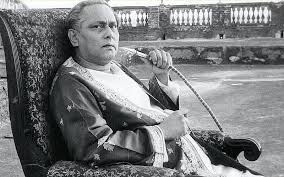
I asked Ivory what they had talked about at that first meeting. ‘He was waiting in the coffee house,’ Ivory said, ‘while the censor was seeing Devi (the coffee house was in the shadow of the Metro Cinema), then somebody came from his staff and said that Devi had gone down’ well with the censors. He was kind of nervous about it because of the retrograde view of Hindu life at its most superstitious, let’s say. He was afraid they would make him cut it. But no, it had gone down all right, and he said, would I like to come to the premiere of it, which I did, so I saw the film at the premiere and I was also introduced to Sharmila Tagore, who was very young then. And then he arranged for me to see Jalsaghar.
So, we went to the studio in Tollygunge where he made all his films and he sat next to me and translated for me at important moments. I thought it was a marvelous, marvelous movie and I jumped up and told him so at the end. He was surprised that I thought it was so marvelous. He said, well, he thought technically it wasn’t so good, wasn’t quite up to the mark. I said well, it didn’t strike me like that, and I asked if there were any plans to show it in the west, for I thought people would really like it. He said no, he didn’t have any plans. It had been shown at the Moscow film Festival, but the Russians didn’t like it because they thought it was decadent and that had discouraged him. I said, I thought he might get a different reception in the west if he pursued it. It was released here in the fall of 1963, and as you know a few years ago it was released in Paris and it was a tremendous success – ran for a year or something.’
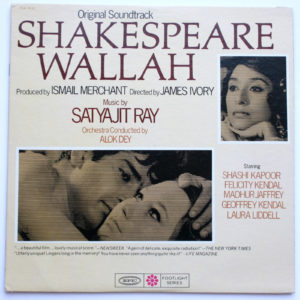
Ray was to collaborate with James Ivory and Ismail Merchant on two of their films: he wrote the music for Shakespearewallah and helped with the editing of The Householder. I asked Ivory how the collaboration had come about. ‘After The Householder was edited,’ he said, ‘it still seemed very unwieldy, not very nicely done, I didn’t really have a very good editor – by this time I had met him [Ray] and I asked if I could bring the film to show him. He said, sure come on. So, Ismail [Merchant] and I climbed on the train – we took the Hindi version of it, all those cans, there must have been 24 cans or something. We went from Bombay to Calcutta with all that film. He saw it and liked it – he thought there was something to work with. I asked him whether he could give us any suggestions about the cutting, and he said – yes. He would recut it, but he didn’t want me to interfere while he was doing that. He said let me have a go at it, I’ll do it my way, you can be in the editing room if you want to be, when we’re all done you can change it if you want to, that’s your business, but let me do what I want to do. So, then he and his editor Dulal Dutt recut the film. They took about four days and gave it a new shape. It was he [Ray] who suggested that it go into a flashback form.
‘Ray was always awfully generous with his time, always, always. I don’t know how he did it; because there were always many people there, who wanted things done, people who just came to catch a glimpse of him and so on. How he had any kind of life of his own and how he made his movies I don’t know.’ Pather Panchali, to my mind the greatest of Ray’s films, was completed in 1955. It premiered not in Kolkata, but in New York, at the Museum of Modem Art. This is how it came about in 1954 Huston was on his way to India to scout locations for ‘The Man Who Would Be King’, when he came to hear of a young advertising-executive who was making a film on a tiny budget. By the time Huston arrived in Kolkata, the film had been stalled for several months, because of a lack of money. At the time of Huston’s visit, the dominant genre in India was the Bombay film. Ray’s work took Huston by surprise. It was apparent from the rushes that this film belonged in a different order of filmmaking, Huston was quick to recognize the genius of the work. He viewed only twenty-minutes or so of the film, but recalling the occasion in 1987, he said: ‘I recognized the footage as the work of a great film-maker,’ Returning to the United States, Huston’s reports of the film were instrumental in persuading the Museum of Modem Art to send Ray some money. MOMA’s advance went a long way towards the completion of Pather Panchali.
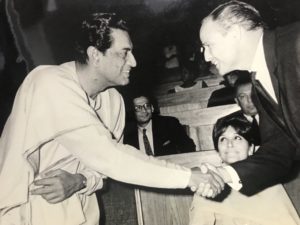
Hollywood had long cast a binding spell on Ray: he was an ardent admirer of such American filmmakers as John Ford and Billy Wilder. Although he never worked there, Hollywood came to play a peculiarly serendipitous role in his life; never more so than when one of his idols, John Huston, made it possible for him to complete Pather Panchali. And thus, it happened that this most famous of contemporary Indian films premiered not in Kolkata or Mumbai, but in New York. It was first shown at the Museum of Modern Art in April 1955, to a small invited audience. Pather Panchali was released in the U.S. (by Edward Harrison) in September 1958 at New York’s Fifth Avenue Theatre. The release was the occasion of Ray’s first visit to the country: he was then thirty-seven. The reception of the film was by no means uniformly enthusiastic. As Ivory describes it ‘There was a famous review by Bosley Crowther which was meant to have been such a putdown. I read that again the other day and actually he was trying to like it. He was baffled, he made false assumptions, he didn’t really know what to say, but he had to admit that he knew or felt, somehow, dimly that there was something great there and he better not say something too bad about it. And apparently there were many, many, people who wrote angry letters about his review’
Thirty-one years later, in Columbia University’s Butler library, I dug up a copy of an interview that Ray gave to Howard Thompson (of the New York Times) on the day of the release. Ray evidently made quite an impression on Thompson: ‘A strapping swarthy chap, with strong features, he (Ray) talks like a realistic poet, without the slightest foreign accent, looking fresh from the American gridiron.’
Thompson continues: ‘On the day after his arrival he (Ray) stepped inside a fashionable hotel dining room, comfortably clad in occidental garb, and gamely stooped to let the head waiter pin on a Plaza tie. Presently, wearing a casually alert expression, the big rangy Calcuttan sat at a table, opening a package of cigarettes with long, tapering fingers. He had been up early, he said, just walking, camera in hand, an old habit of ‘an old film fan”.
This is how Ray described the filming of Pather Panchali to Thompson: ‘We shot in and around Calcutta, then had to stoop for six months because I was flat broke. I even sold part of my record collection, some old seventy-eights of Bach, Mozatt and Beethoven – and part of my wife’s jewelry not that her mother knew. All that was shown again to the same [financiers]. No reaction. Then a year’s gap’.
Ray was able to continue filming only because of an unlikely intervention a powerful West Bengal politician, reputed to be ‘close’ to one of Ray’s aunts, authorized a grant from the state government. He was under the impression evidently, that Pather Panchali was a documentary about community development. In response to a question about the future of Indian film: Ray told Thompson: ‘I don’t know if our pictures generally will ever spread to a world market, though we have two or three young directors with the right ideas. Our industry centers productionally in Bengal, Madras and Bombay, but those from Bengal are better, more serious. As for why you don’t see more of ours – well, we have our own problems and we’re not so sure Westerners care’.
“The generous mouth widened slightly’, Thompson continues. ‘Do you?’ he inquired. The penetrating brown eyes twinkled pensively.
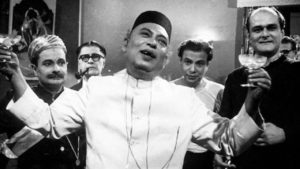
Looking back now, I am more than ever aware of him wearing a casually alert expression, the big rangy Calcuttan sat at a table, opening a package of cigarettes with long, tapering fingers. He had been in ghost stories and the fantastical. One of my favorite Ray films to this day, remains Paras Pathar (“the Philosopher’s Stone’), a neglected masterpiece that deserves a place of honor in the canon of surrealist cinema. When I saw Agantuk [‘The Stranger’, in which the main character is an anthropologist] I began to wonder whether my interest in anthropology too, owed something, perhaps subconsciously, to Ray: I recalled suddenly that references to anthropology go back to some of his earliest work starting with the African mask in Apur Sansar.
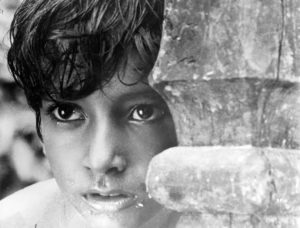
Ray’s influence extended even to the material world that I inhabited in my early years; a world which he formed to a quite astonishing degree through his influence on typography and through his visual style – a style that was itself a development on the distinctive design traditions of Bengal. That he could exert such great influence was due in part to the fact that his work extended and developed the legacy of the generations preceding his.
His greatness as an artist is in no way diminished by the fact that he was a rivet in an unbroken chain of aesthetic and intellectual effort that stretches back to the mid-nineteenth century – a chain in which I too am, I hope, a small link, Ray was for me, not just a great artist; he was something even rarer: an artist who had crafted his life so that it could serve as an example to others.

In a world where people in the arts are often expected, even encouraged, to be unmindful of those around them, he was exemplary in his dealings with people. This was, I think, one of the reasons why he was able to sustain his creative energies for as long as he did: because he refused to make a fetish of himself. As a student I had heard him speak on several occasions: it always seemed to me that there was something very private about his manner. I had the sense that it was by holding the world at arm’s length that he had managed to be as productive as he had. This was a stance I respected then and respect even more today, now that I am more aware of how easy it is to be distracted by the demands of public life.
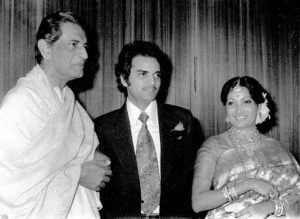
Ray was consistent in fighting off the pressures of the wider world. After the success of Pather Panchali he was feted by Jawaharlal Nehru and Indira Gandhi. It was a measure of his integrity that he never allowed their praise and attention to distract him from his own projects. Unlike many other filmmakers in India, Ray consciously avoided seeking government financing for his projects, preferring to raise the money from commercial sponsors. He was always deeply aware of his audience in Kolkata and gloried in the discipline they imposed on him – primarily that of keeping his work accessible. This meant that he could never permit himself the luxury of avant-gardism in the manner of his European contemporaries such as Fellini, Bergman and Godard: nor indeed did he ever want to. To the end one of his greatest strengths was his ability to resolve enormously complex plots and themes are resolved into deceptively simple narrative structures.
My favorite Ray story is one I came upon soon after I learnt of the appalling human cost of Werner Herzog’s ‘Fitzcarraldo’. Once, while filming an overhead shot, a falling piece of machinery gravely injured a studio-hand who was working on one of Ray’s sets. Ray never used an overhead shot again.

In 1992 when Hollywood awarded him an Oscar for Lifetime Achievement, Ray was so ill that he received the award lying in his hospital bed. The scene was broadcasted on TV and when I saw it I realized that Ray’s illness was so serious that he might not recover. I had always assured that I would meet Ray one day, but I had never made an effort to seek him out. He was such an integral part of my imaginative world that I’d fought shy of meeting him face-to-face: what can one possibly say to someone to whom one owes so great a debt? In 1989 and 1990 I had had several telephone conversations with him. In one of them he’d told me that he had greatly enjoyed my first novel, The Circle of Reason. Now I saw that it was I who had been remiss in expressing my admiration and gratitude. In light of his condition this assumed a sudden urgency. I decided to write a letter to Ray asking if I could visit him. My letter began:
Dear Mr. Ray,
I have wanted to write to you for many years now, but have always put it off because I knew it would not be easy to say what I wanted to …
It ended:
The Japanese have a custom which allows people to pay homage to artists they admire by standing outside their houses, alone and in silence, until they are invited in. You are the only person in the world for whom I would gladly do that…
The letter was dated February 6, 1992. I gave it to Shri Nirmalya Acharya, a close associate of Ray’s and himself one Kolkata’s legendary literary figures (now sadly deceased and much missed by all who knew him). Nirmalya-babu promised to hand it to Ray once he was well enough to read. Alas that day never came: Satyajit Ray died on April 23, 1992. The day of Satyajit Ray’s death was like none that Kolkata had ever seen before. When the news began to spread, a pall of silence descended on the city. Next morning hundreds of thousands of people flied past his body, braving the intense heat. In the evening when his body was taken to the crematorium, the streets were thickly lined with people standing in silent vigil. Many held up placards which referred to him as’ The King’. The whole city was sunk in an inexpressible sadness: everybody knew that an era had ended, and with it, Kolkata’s claim to primacy in the arts. The city was orphaned: its king was gone and there was none to take his place.
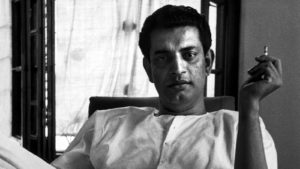
I wandered the streets for hours that night, watching the silent crowds, reading the placards. I was Surprised by the depth of my own sense of loss. Yet I was also of an immense sense of privilege, of gratitude, that having been born in Kolkata I had, in some small way, been endowed with a special entitlement to Ray’s universe; gratitude at having had his work to illuminate my surroundings and my past. This is what the narrative arts do, at their very best: they shape the world as they relate them. To this day Ray’s work is one of the main anchors that moors me – often despite myself to the imaginative landscape of Bengal: indeed, to the essential terrain of my own work.


Very detailed and exhaustive